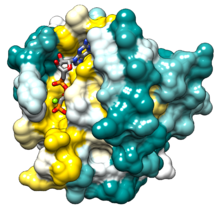Ras (protein)

|
|||||||||
| Identifiers | |||||||||
|---|---|---|---|---|---|---|---|---|---|
| Symbol | Ras | ||||||||
| Pfam | PF00071 | ||||||||
| InterPro | IPR020849 | ||||||||
| PROSITE | PDOC00017 | ||||||||
| SCOP | 5p21 | ||||||||
| SUPERFAMILY | 5p21 | ||||||||
| CDD | cd04138 | ||||||||
|
|||||||||
| Available protein structures: | |
|---|---|
| Pfam | structures |
| PDB | RCSB PDB; PDBe; PDBj |
| PDBsum | structure summary |
Ras is a family of related proteins which is expressed in all animal cell lineages and organs. All Ras protein family members belong to a class of protein called small GTPase, and are involved in transmitting signals within cells (cellular signal transduction). Ras is the prototypical member of the Ras superfamily of proteins, which are all related in 3D structure and regulate diverse cell behaviours.
When Ras is 'switched on' by incoming signals, it subsequently switches on other proteins, which ultimately turn on genes involved in cell growth, differentiation and survival. Mutations in ras genes can lead to the production of permanently activated Ras proteins. As a result, this can cause unintended and overactive signaling inside the cell, even in the absence of incoming signals.
Because these signals result in cell growth and division, overactive Ras signaling can ultimately lead to cancer. The 3 Ras genes in humans (HRas, KRas, and NRas) are the most common oncogenes in human cancer; mutations that permanently activate Ras are found in 20% to 25% of all human tumors and up to 90% in certain types of cancer (e.g., pancreatic cancer). For this reason, Ras inhibitors are being studied as a treatment for cancer and other diseases with Ras overexpression.
The first two ras genes, HRAS and KRAS, were identified from studies of two cancer-causing viruses, the Harvey sarcoma virus and Kirsten sarcoma virus, by Edward M. Scolnick and colleagues at the National Institutes of Health (NIH). These viruses were discovered originally in rats during the 1960s by Jennifer Harvey and Werner Kirsten, respectively, hence the name Rat sarcoma. In 1982, activated and transforming human ras genes were discovered in human cancer cells by Geoffrey M. Cooper at Harvard,Mariano Barbacid and Stuart A. Aaronson at the NIH,Robert Weinberg at MIT, and Michael Wigler at Cold Spring Harbor Laboratory. A third ras gene was subsequently discovered by researchers in the group of Robin Weiss at the Institute of Cancer Research, and Michael Wigler at Cold Spring Harbor Laboratory, named NRAS, for its initial identification in human neuroblastoma cells.
...
Wikipedia
